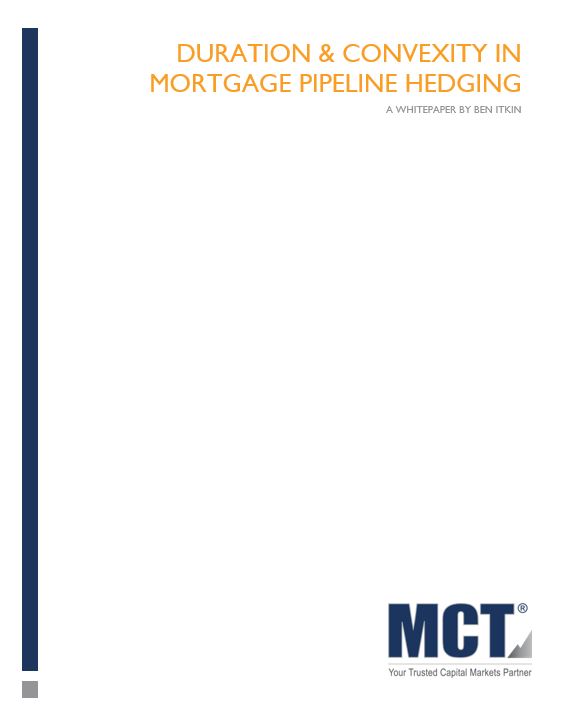
MCT Whitepaper: Duration & Convexity in Mortgage Pipeline Hedging
The intricate world of mortgage pipeline hedging demands a nuanced understanding of key concepts such as duration, convexity, and the interplay between various market dynamics. In this whitepaper, MCT dives into the importance of grasping these concepts to effectively navigate the complexities of mortgage markets.
MCT’s Managing Director, Head of Sales, Ben Itkin, explains these concepts using example hedging and duration calculations with valuable insights for secondary market professionals.
Fill out the form to download the whitepaper.
Download Whitepaper
This whitepaper underscores the critical significance of understanding concepts like duration and convexity in mortgage pipeline hedging, which are pivotal for effectively managing risk and maintaining margins amidst market fluctuations. Examining the relationship between TBA coupon & mortgage price sensitivity reveals essential insights into market dynamics. By reviewing these concepts and strategies, this whitepaper aims to provide valuable insights for secondary market professionals managing a mortgage pipeline.
In this whitepaper, MCT dives into the importance of grasping the concepts of duration and convexity in mortgage pipeline hedging.
Topics Include:
- Defining Durations in Mortgage Pipeline Hedging
- Example Hedging Scenarios & Duration Calculations
- Understanding Convexity in Relation to Duration
- Hedging with TBAs or Treasuries: Explaining the Difference
Download our whitepaper today to learn more about duration and convexity!

Ben Itkin, Managing Director, Head of Sales, MCT
Mr. Itkin brings more than 25 years of mortgage and capital markets experience to MCT’s management team. He is highly regarded in the mortgage industry, holds deep knowledge in secondary marketing, loan pricing and pipeline hedging. He has been instrumental in expanding and working closely with MCT’s team of trading analysts to provide hands-on service to clients. Prior to MCT, Mr. Itkin was the SVP for BofA’s Negotiated Trade Desk for its correspondent lending channel. Before that, he was the First VP of Negotiated Trading for Countrywide Home Loans, where he also held the position of First VP of Bulk Trading for its correspondent lending business. Mr. Itkin was also a Senior Brand Manager in the warehouse lending unit at Indymac Bank.

Featured Whitepaper Excerpts:
Defining Durations in Mortgage Pipeline Hedging
Duration is a linear formula to calculate the price sensitivity of a bond (or, in this case, a mortgage pipeline) to a change in interest rates. The calculation incorporates the weighted-average maturity of cash flows and depicts the percent change in pipeline value you would expect given a 1% change in rates.
It is important to note that the calculation of the weighted-average maturity of cash flows is not simply the anticipated time a loan pays off. For example, if a mortgage pays off in five years, the principal and interest will be collected for the first four years, then the balance of the loan on the fifth year. Because some of the cash flow (through interest payments) is collected in the first four years, the duration of the loan will drop to below five years, for instance 4.8 years. Examples of duration calculation will be explored on page 3, but first, how do durations apply to mortgage pipeline hedging?
When Applying TBA Cross-Hedging is Appropriate
Understanding a lender’s unique cost to originate is often the best starting point in setting margin. It may also open doors to other issues operationally which could further that lender’s ability to set margin more competitively. Investment in technology is paramount in today’s environment. Focusing on this one area can lead to reduced cycle time, increased efficiencies, higher customer satisfaction, and a referral basis that promotes additional growth as well as improving overall pull-through rates. Technology can come at a cost that must be factored into the overall cost to originate, but if implementation leads to gains that exceed the current process costs it is worth the money spent.
Hedging with TBAs or Treasuries: Explaining the Difference
Treasuries and TBAs have both been used as hedge instruments in the mortgage space for decades as they move in close correlation to one another. While there are some structural advantages to Treasures, they do “delink” from TBAs from time to time, creating what is known as “basis risk”, where the expected correlation between the hedge and the mortgage pipeline breaks. As stated earlier, TBAs are the primary driver of the agency mortgage price. Thus, using TBAs virtually eliminates this sort of basis risk. It is for this reason that the vast majority of agency mortgage hedging strategies look to the TBA as the primary hedge vehicle.
